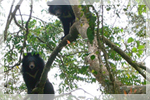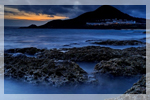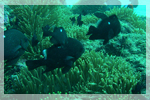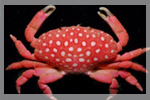|
|
|
 |
 |
Strategies of wildlife DNA identification for forensic applications — constituting the theme, approach and methodology of this workshop — are based on research findings derived from more than 10 years of studies conducted at the laboratories of the instructors in Taiwan and University of Strathclyde in Scotland.
This will be an intense one-day workshop covering the methodology with a hands-on exercise (following steps of a standard operation procedure) on genetic approaches developed in the instructors’ laboratory to unambiguously identify the origins of species of conservation significance. PCR or nested PCR based on the nature of DNA was used for amplification of cyt b, COI, CHD, and D-loop DNA fragments. Sequences of these fragments were compared with those registered in DNA databases and phylogenetic analysis was performed. This identification system is now routinely applied to the analysis of specimens (animal residues, powders, and processed products seized in wildlife-related investigations) of alleged rhinoceros horns, Indian sawback turtles, shahtoosh, ivories, dolphins, whales, etc. It is also applied to the investigation of fraudulent content labeling of food products in the Taiwanese market. |
|

|
| 08:30 – 09:00 |
Registration & Coffee |
| 09:00 – 09:30 |
Introduction |
| 09:30 – 10:30 |
Strategy of DNA Extraction |
| 10:30 – 10:50 |
Break & Informal Discussion |
| 10:50 – 12:00 |
General Species Identification |
| 12:00 – 13:00 |
Lunch & Informal Discussion |
| 13:00 – 14:10 |
Specific Species Identification |
| 14:10 – 14:30 |
Break & Informal Discussion |
| 14:30 – 15:40 |
Sequence Analysis |
| 15:40 – 16:00 |
Discussion |
|
|
 |
- H.-M. Hsieh, H.-L. Chiang, L.-C. Tsai, S-Y Lai, N.-E. Huang, A. Linacre, J. C.-I Lee. 2001. Cytochrome b gene for species identification of the conservation animals. Forensic Sci Int 122: 7–18.
- H.-M. Hsieh, L.-H. Huang, L.-C. Tsai, H.-H. Meng, Y.-C. Kuo, A. Linacre, J. C.-I Lee. 2003. Species identification of rhinoceros horns using the cytochrome b gene. Forensic Sci Int 136:1–11.
- H.-M. Hsieh, C.-C. Tsai, L.-C. Tsai, H.-L. Chiang, N.-E. Huang, R. T.-P. Shih, A. Linacre, J. C.-I Lee. 2005. Species identification of meat products using the cytochrome b gene. Forensic Science Journal 4:29–36.
- H.-M. Hsieh, L.-H. Huang, L.-C. Tsai, C.-L. Liu, Y.-C. Kuo, C.-T. Hsiao, A. Linacre, J. C.-I Lee. 2006. Species identification of Kachuga tecta. Using the Cytochrome b Gene. J Forensic Sci 51:52–56.
- J. C.-I Lee, L.-C. Tsai, C.-Y. Yang, C.-L. Liu, L.-H. Huang, A. Linacre, H.-M. Hsieh. 2006. DNA profiling of shahtoosh. Electrophoresis 27: 3359–3362.
- L.-C. Tsai, M.-T. Huang, C.-T. Hsiao, A. C.-Y. Lin, S.-J. Chen, J. C.-I Lee, H.-M. Hsieh. 2007. Species identification of animal specimens by cytochrome b gene. Forensic Science Journal 6:63–65.
- J. C.-I Lee, L.-C. Tsai, Y.-Y. Kuan, W.-H. Chien, K.-T. Chang, C.-H. Wu, A. Linacre, H.-M. Hsieh. 2007. Racing pigeon identification using STR and chromo-helicase DNA binding gene markers. Electrophoresis 8:4274–4281.
- J. C.-I Lee, L.-C. Tsai, M.-T. Huang, J.-A. Jhuang, C.-T. Yao, S.-C. Chin, L.-C. Wang, A. Linacre, H.-M. Hsieh. 2008. A novel strategy for avian species identification by cytochrome b gene. Electrophoresis 29:2413–2418.
- H.-M. Hsieh, S.-P. Liao, C.-T. Hsiao, L.-H. Huang, Y.-C. Kuo, A. C.-Y. Lin, J. C.-I Lee, L.-C. Tsai. 2008. Species identification of fragmented turtle shells by cytochrome b gene. Forensic Science Journal 7:45–47.
- J. C.-I Lee, H.-M. Hsieh, L.-H. Huang, Y.-C. Kuo, J.-H. Wu, S.-C. Chin, A.-H. Lee, A. Linacre, L.-C. Tsai. 2009. Ivory identification by DNA profiling of cytochrome b gene. Int J Legal Med 123:117–121.
- J. C.-I Lee, L.-C. Tsai, S.-P. Liao, A. Linacre, H.-M. Hsieh. 2009. Species identification using the cytochrome b gene of commercial turtle shells. Forensic Sci Int Genet. 3:67–73.
- L.-C. Tsai, J. C.-I Lee, S.-P. Liao, L.-H. Weng, A. Linacre, H.-M. Hsieh. 2009. Establishing the mtDNA D-loop structure of Columba livia. Electrophoresis 30: 3058–3062.
- J. C.-I Lee, L.-C. Tsai, P.-Y. Hwa, C.-L. Chan, A. Huang, S.-C. Chin, L.-C. Wang, J.-T. Lin, A. Linacre, H.-M. Hsieh. 2009. A novel strategy for avian species and gender identification using the CHD gene. Molecular and Cellular Probes 24:27–31.
- H.-M. Hsieh, J. C.-I Lee, J.-H. Wu, C.-A. Chen, Y.-J. Chen, G.-B. Wang, S.-C. Chin, L.-C. Wang, A. Linacre, L.-C. Tsai. 2010. Establishing the pangolin mitochondrial D-loop sequences from the confiscated scales. Forensic Sci Int Genet (2010), doi:10.1016/j.fsigen.2010.06.003 [2010 Jul 15.Epub ahead of print]
|
|
|
 |
 |
Post-conference visits in Taiwan will take us to Jiji, Nantou County (in the central area) and Kenting, Pingtung County (at the southern tip). These sites (as further described later) were chosen to reflect the natural and ecological systems endemic to Taiwan.
With so many outstanding zoos and aquariums available elsewhere in the world, such facilities have been excluded from the Taiwan itinerary. For those who can stay for a few more days, we do recommend visits to the National Palace Museum (Taipei), the Taroko National Park (Hualien County in the northeast), and the Yushan National Park (Yushan Peak, 3,952 meters above sea level, the highest point on the island). |
|

|
| Date |
Tentative Schedule |
Activity |
Nov. 5
(Saturday) |
06:30 – |
Breakfast |
| 07:30 – 08:00 |
Assembling |
| 08:00 – |
Departing (for Jiji, Nantou) |
| 11:00 – 12:30 |
Visiting Endemic Species Research Institute |
| 12:30 – 13:30 |
Lunch |
| 13:30 – |
Departing (for Kaohsiung) |
| 16:30 – |
Check-in |
| 17:30 – 18:30 |
Dinner |
| 18:30 – |
Exploring Kaohsiung (individually or in groups) |
Nov. 6
(Sunday) |
06:30 – |
Breakfast |
| 07:30 – 08:00 |
Assembling |
| 08:00 – |
Departing (for Kenting) |
| 10:00–11:30 |
Touring Eluanbi Park |
| 11:30 – 12:15 |
Viewing points of interest in the Kenting area (on bus) |
| 12:15 – 13:30 |
Lunch |
| 13:30 – 16:30 |
Visiting Kenting National Forest Recration Area |
| 16:30 – |
Check in |
| 17:30 – 18:30 |
Dinner |
| 18:30 – |
Exploring Kenting (individually or in groups) |
Nov. 7
(Monday) |
06:30 – |
Breakfast |
| 08:30 – 09:00 |
Assembling |
| 09:00 – |
Departing (returning to Kaohsiung and beyond) |
|
|
 |
| Endemic Species Research Institute (Jiji, Nantou) |
|
Established in 1992 as an experimental research organization, the Endemic Species Research Institute (ESRI) is now under the jurisdiction of the Taiwanese Council of Agriculture. The primary missions of ESRI include undertaking surveys and research on Taiwan’s rare and endemic wild animals, plants, habitats, and ecosystems, as well as promoting ecological education.
Located in Jiji, Nantou Conuty, ESRI’s research efforts on the Formosan black bear, an endangered species facing extinction,
have helped accumulate a significant amount of biological/ecological, behavioral, and genetic data on this bear. These data have been very helpful to better understanding, and hopefully for more effective conservation, of this species endemic to Taiwan.
The museum (together with the Biological Education Park and the Butterfly Park) housed in ESRI nicely provide “[t]he endemic species profile in Taiwan—975 endemic species [among] 4,000 species of vascular plants, 15 [among] 450 species of birds, 27 [among] 85 species of reptiles, 50 [among] 400 species of stag beetles, and more”. |
 |
| by Hong Song |
 |
| by Kay-Wu Fan |
| |
|
|
| Helpful websites: |
|
http://tesrieng.coa.gov.tw/show_index.php
http://mmweb.tw/71155/info/
http://mmblog.tw/lucyaaa/article/31334/ |
|
|
| |
| Kenting National Park (Kenting, Pingtung) |
“Dazzling bright sunshine, azure blue seawater, clean shining sand beach …, this is Taiwan’s first national park-Kenting, renowned for its rich landscape of hills and water, abundant [wildlife], and natural resources ...”
“Kenting National Park is located at the southern tip of Taiwan. With warm climate, pleasant scenery, and easy access, it is one of the most popular resorts, attracting millions of both domestic and foreign tourists every year. The diversified terrain and tropical climate of Kenting have helped breed a rich and fertile vegetation ranging from upland to coast with a full variety of living species. Combined with its existing facilities and professional interpretation services and activities, this national park offers a profound, insightful, and inspirational ecological journey.” You will enjoy a guided tour of the park. |
 |
| by Paul Chen |
| |
|
|
 |
 |
 |
| from happytellus.com |
from anorak.co.uk |
|
|
| |
| Helpful websites: |
http://www.ktnp.gov.tw/eng/index.aspx
http://en.wikipedia.org/wiki/Kenting_National_Park
http://sinotour.com/tourguide/pingtung/kenting-national-park.html
http://www.google.com.tw/images?hl=zh-TW&q=kenting+national+park&um=1&ie=UTF-8&source=univ&sa=X&ei=o5mCTZyRMojcvwPmu-jJCA&ved=0CFAQsAQ&biw=1311&bih=637 |
|
|
|
|
|
|
|

